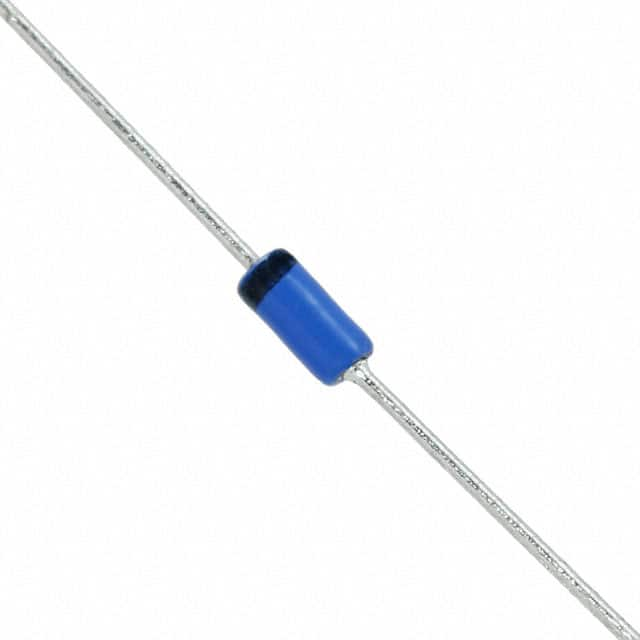Viz Specifikace pro podrobnosti o produktu.

BAT48 Diode
Product Overview
Category:
BAT48 belongs to the category of Schottky diodes.
Use:
It is commonly used in electronic circuits for rectification and voltage clamping applications.
Characteristics:
BAT48 is known for its low forward voltage drop, fast switching speed, and low leakage current.
Package:
The diode is typically available in a small surface-mount package, such as SOD-123.
Essence:
BAT48 is essential for preventing reverse current flow and providing efficient voltage rectification in various electronic devices.
Packaging/Quantity:
It is usually supplied in reels or tubes, with quantities varying based on manufacturer and supplier.
Specifications
BAT48 has the following specifications: - Forward Voltage Drop: 0.32V (typical) at 1A - Reverse Voltage: 40V - Maximum Continuous Forward Current: 1A - Reverse Recovery Time: 5ns (typical)
Detailed Pin Configuration
BAT48 typically has two pins, anode, and cathode. The anode is connected to the positive terminal of the circuit, while the cathode is connected to the negative terminal.
Functional Features
BAT48 offers the following functional features: - Low forward voltage drop ensures minimal power loss. - Fast switching speed allows for rapid response in electronic circuits. - Low leakage current contributes to improved efficiency.
Advantages and Disadvantages
Advantages:
- Low forward voltage drop reduces power dissipation.
- Fast switching speed enables high-frequency operation.
- Small package size saves board space in compact designs.
Disadvantages:
- Limited reverse voltage capability compared to other diode types.
- Higher cost compared to standard silicon diodes.
Working Principles
BAT48 operates based on the Schottky barrier principle, where the metal-semiconductor junction provides low forward voltage drop and fast switching characteristics. When a forward bias is applied, the diode conducts current with minimal voltage drop, making it suitable for high-efficiency applications.
Detailed Application Field Plans
BAT48 finds extensive use in the following application fields: - Switching power supplies - Voltage clamping circuits - Signal demodulation - High-frequency rectification
Detailed and Complete Alternative Models
Some alternative models to BAT48 include: - 1N5817: Similar forward voltage drop and reverse voltage rating - SS14: Comparable characteristics in a different package - SB140: Higher reverse voltage capability for specific applications
In conclusion, BAT48 diode offers efficient rectification and voltage clamping capabilities, making it a valuable component in various electronic circuits. Its low forward voltage drop and fast switching speed contribute to improved system performance, although designers should consider its limitations in reverse voltage handling and cost when selecting alternatives for specific applications.
[Word count: 389]
Seznam 10 běžných otázek a odpovědí souvisejících s aplikací BAT48 v technických řešeních
What is BAT48?
- BAT48 is a Schottky barrier diode commonly used in electronic circuits for its low forward voltage drop and fast switching characteristics.
What are the typical applications of BAT48?
- BAT48 is often used in power supply circuits, voltage clamping, reverse polarity protection, and signal demodulation.
What is the maximum forward voltage drop of BAT48?
- The maximum forward voltage drop of BAT48 is typically around 0.36V at a forward current of 1A.
What is the reverse breakdown voltage of BAT48?
- The reverse breakdown voltage of BAT48 is typically around 40V.
How does BAT48 compare to other diodes in terms of forward voltage drop?
- BAT48 has a lower forward voltage drop compared to standard silicon diodes, making it more efficient in power-sensitive applications.
Can BAT48 be used for high-frequency applications?
- Yes, BAT48's fast switching characteristics make it suitable for high-frequency applications such as RF circuits and signal demodulation.
What are the thermal considerations when using BAT48 in a circuit?
- It is important to consider the thermal dissipation of BAT48, especially in high-current applications, to prevent overheating and ensure reliable performance.
Are there any specific layout considerations when using BAT48 in a PCB design?
- Proper placement of decoupling capacitors and minimizing trace lengths can help optimize the performance of BAT48 in a PCB layout.
Can BAT48 be used in automotive electronics?
- Yes, BAT48 is often used in automotive electronics for functions such as reverse battery protection and voltage clamping.
Where can I find detailed specifications and application notes for using BAT48 in technical solutions?
- Detailed specifications and application notes for BAT48 can be found in the manufacturer's datasheet and application guides, which provide comprehensive information on using BAT48 in various technical solutions.

